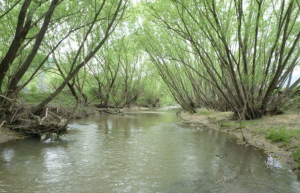Summary of an article originally published in The Conversation
The word “weed” usually brings to mind smallish plants like trad, onion weed, agapanthus and possibly cotoneaster, but trees can also be weeds!
When you think of what makes a plant a weed, it makes sense that trees can fit the bill. Weeds are plants that are not wanted and are usually growing outside their natural habitat. They grow quickly, may produce lots of seed that can be easily dispersed, may easily grow vegetatively from parts of the plant (e.g. sucker or grow from pieces broken off the plant) and suppress other plants from growing around them in various ways.
It’s not hard to think of examples of trees that have these features of weeds. A prime example is the radiata pine (Pinus radiata), native to the USA and widely planted in Australia for timber and farm windbreaks. It is a prolific seeder, with seeds being spread up to one kilometre by wind, and grows quickly. Its thick blanket of leaf litter can reduce soil fertility and prevent native plants from growing, resulting in reduced biodiversity.

Another exotic tree weed is the willow (Salix spp.), which is a northern hemisphere native and has been planted in Australia along creek lines to prevent erosion. It has become a major weed here, as it grows quickly from seed and suckers, displaces native riparian vegetation, affects creek flows and destroys animal habitat.
Not only exotic trees can become weeds in Australia. Our very own native trees can also turn on us! A familiar example to most of us, as it’s widely planted in gardens, is the Cootamundra wattle (Acacia baileyana). Outside its own native range, it can outcompete many other native shrubs and ground flora. It may also hybridise with some other Australian wattles and, in this way, reduce the genetic integrity of wattle populations.
A second Australian offender is the blackwood (Acacia melanoxylon), another popular garden tree. It tolerates quite diverse habitats and soils, is resistant to fungi that can easily kill other native plants and produces long-lived seed that is easily spread by birds. It can also spread from root suckers, as can many of Australia’s Acacia species. Wattles are not getting a good rap here!
There are quite a number of other examples of weeds that are trees. Australia isn’t the only victim, though. Some of our native trees are causing major weed problems overseas, such as the broad-leafed paperbark (Melaleuca quinquenervia) in Florida and the river red gum (Eucalyptus camaldulensis) in southern Africa.
As with any weed, we need to control trees that are weeds too. The particular context – garden, native bushland or agricultural environments – will clearly influence our approach. We do not have a good history here. Unsurprisingly, prevention is better than cure! One of the best strategies for gardeners to prevent a new tree (or any plant!) from becoming a weed is to do some homework on whether that plant is suitable for your area and also join a local gardening or environmental group to deal with local weed problems. If we act together in this way, we can collectively reduce weed problems for future generations.
